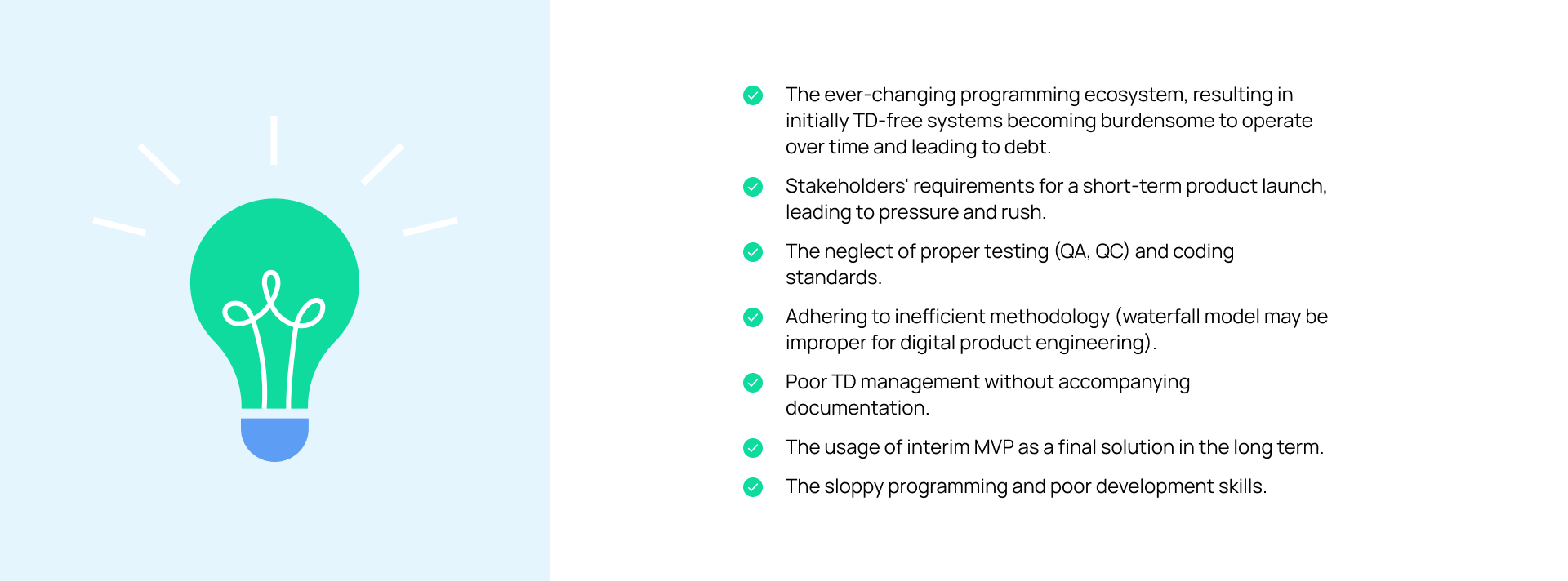How to develop digital products to avoid technical debt

How to deal with technical debt? Learn about top proven strategies and find out more about how to keep technical debt from derailing your medical project.
What never stands still? Yes, it's time, and perhaps another crucial thing — the evolution of technology, especially in the healthcare industry. These two components, along with the heightened expectations of today's healthcare market, compel software companies to act without delay to deliver a solid solution, outpacing competitors and satisfying customers.
But in this seemingly happy ending, there is also room for unfortunate reality: the neglect of product quality for the sake of speedy time-to-market that soon makes itself felt. As a result, developers can be under significant pressure to cope with technical debt, generating unnecessary business expenses for companies.
In the best case, a company will spend money and time only on code refactoring; in the worst case, a project will flop, and a product will become non-viable. Therefore two questions arise:
- Does a quickly released solution necessarily generate serious challenges for software companies with future upgrades?
- And is technical debt so unsafe for your medical business?
The answer is quite controversial, but the first place to start is to figure out the nature of code debt. It allows you to identify, value, and minimize tech debt within your project.

The essence of technical debt
Ward Cunningham first introduced the term in 1992. The internationally renowned developer compared technical debt (TD) to a financial one, where you take out a loan and eventually pay it off, along with interest.
In coding, technical debt means the usage of a temporary easy-to-realize solution to produce immediate results, ignoring the solution's effectiveness in the long run. Simply put, these are accrued challenges with the solution's code and architecture in prior iterations that need to be addressed in the future.
According to the Stepsize report, 60% of engineers think TD leads to bugs, system failures and affects workflow productivity [1]. The main trick is that code debt cannot be avoided. It is something you have to put up with. But pinpointing its causes during digital product engineering can lead to positive results: clean code, solution efficiency, speedy release, and the possibility of seamless scalability in the post-launch phase.

Why does code debt occur?
Some organizations deliberately accrue TD as a tradeoff for speedy product delivery, while some do it unintentionally due to shifting market requirements, or business goals.
Often the addition of an unknown system specification during the workflow can also cause unintended debt accrual. It usually occurs when there is no clear idea of what the solution should look like or how to build it. In such a situation, additional requirements arising in the work process are common, but they can become a bottleneck.
There are also some other reasons for technical debt:

Can tech debt be tolerated?
TD can be an acceptable thing if it is one of the strategic components in the product roadmap. For example, when dealing with product development, coding shortcuts are in place to verify the business hypothesis and the effectiveness of the underlying functions. Once the solution's viability has been proven, it can be advanced, and the code debt paid off.

How to minimize tech debt: 4 strategies to follow
As was mentioned above, it is impossible to completely exclude TD during coding. Instead, it is essential to adopt tech debt management practices and tune the development process to exempt your business from "interest" accrual.
A McKinsey report shows that companies are able to cut back their debt from 75% to 25% using a rational approach to TD management [2]. Therefore, code debt can prove quite harmless if you are up to date on basic debt control strategies.
1. Identify the nature of tech debt
It is advisable to start by revealing the source of code debt while the project is being carried out. Is it intentional or unintentional? Maybe it results from modified requirements, objectives, or the leverage of an outdated tech stack. A thorough code audit along with a UX/UI one can be carried out at this stage.

2. Set actions and timelines for code debt elimination
Once the source of the debt has been identified, you can start to reduce it. One practice is to schedule a specific time frame and assign tasks to team members to deal exclusively with technical debt.
By the way, some companies have special departments dealing with TD and its control. One of their tasks is to perform refactoring (converting messy code into readable and bug-free one). Still, if you adopt minimal code refactoring as a regular practice, you can get rid of the bulk accumulation of "interest".
3. Implement an agile methodology
The agile method, especially in healthcare software development, is a sprint approach where you can seamlessly repay the debt from iteration to iteration. In addition, the flexibility of the methodology and the ability to put each change to the test make technical debt manageable.
4. Stick to coding standards and perform proper testing
Adherence to coding standards will help achieve clean code that is easy to modify in the future. In turn, performing automated testing will help troubleshoot bottlenecks and evaluate the solution's quality, while QA engineers can focus on carrying out human intervention activities.
Besides, code review is also a valuable tactic where a fresh perspective from other developers will assist in keeping TD accumulation in a tight grip.
Maybe it's time to turn code review into a routine?
5. Consider flexible architecture
Evolution is an integral part of development. Therefore, in order to ensure that your solution can withstand future changes and its further scalability is not a burden on your business, try to decide on a flexible architecture where you can build a system with independent modules and scale them up over time. In fact, such an approach allows you to maintain the system’s integrity without letting TD “absorb” it all.
Conclusion
In medicine, preventive actions are preferable to treatment ones. The same approach is worth adopting in the development of healthcare solutions: the earlier you proceed to prevent technical debt accumulation, the more chance you have of getting a solid solution out and giving it a chance to live on in a world of fierce competition.
But it all starts with a team that has adapted the optimal approach to code debt management and acquired medical expertise to deliver high-quality and future-proof medical solutions. We already have such a team who would be happy to help you realize your healthcare ideas. Just get in touch with us.
References:
- https://assets.website-files.com/5f922f81cc30586744dc7122/60e306c6db6224328eaf47a3_Tech%20debt%20report.pdf
- https://www.mckinsey.com/business-functions/mckinsey-digital/our-insights/tech-debt-reclaiming-tech-equity
- https://www.forbes.com/sites/noahbarsky/2021/04/06/mckinseys-tech-debt-solution-perpetuates-cios-it-modernization-problem/?sh=32e593214427
- https://codescene.com/hubfs/calculate-business-costs-of-technical-debt.pdf
- https://www.sei.cmu.edu/our-work/projects/display.cfm?customel_datapageid_4050=6520
- https://www.edvantis.com/blog/technical-debt/
- https://www.salesforce.com/au/blog/2021/10/how-to-avoid-a-technical-debt-black-hole.html
 Medical Content Creation
Medical Content Creation
 Digital Product Development
Digital Product Development
 Growth Marketing
Growth Marketing
